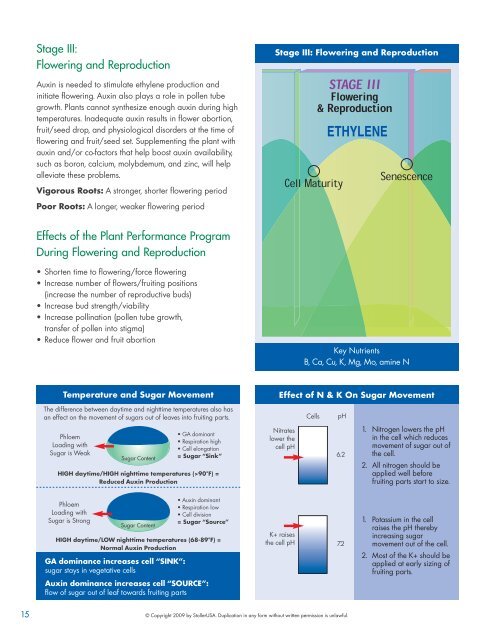Create successful ePaper yourself
Turn your PDF publications into a flip-book with our unique Google optimized e-Paper software.
15<br />
Stage III:<br />
Flowering and Reproduction<br />
Auxin is needed to stimulate ethylene production and<br />
initiate flowering. Auxin also plays a role in pollen tube<br />
growth. <strong>Plant</strong>s cannot synthesize enough auxin during high<br />
temperatures. Inadequate auxin results in flower abortion,<br />
fruit/seed drop, and physiological disorders at the time of<br />
flowering and fruit/seed set. Supplementing the plant with<br />
auxin and/or co-factors that help boost auxin availability,<br />
such as boron, calcium, molybdemum, and zinc, will help<br />
alleviate these problems.<br />
Vigorous Roots: A stronger, shorter flowering period<br />
Poor Roots: A longer, weaker flowering period<br />
Effects of the <strong>Plant</strong> <strong>Performance</strong> Program<br />
During Flowering and Reproduction<br />
• Shorten time to flowering/force flowering<br />
• Increase number of flowers/fruiting positions<br />
(increase the number of reproductive buds)<br />
• Increase bud strength/viability<br />
• Increase pollination (pollen tube growth,<br />
transfer of pollen into stigma)<br />
• Reduce flower and fruit abortion<br />
Temperature and Sugar Movement<br />
The difference between daytime and nighttime temperatures also has<br />
an effect on the movement of sugars out of leaves into fruiting parts.<br />
Phloem<br />
Loading with<br />
Sugar is Weak<br />
HIGH daytime/HIGH nighttime temperatures (>90°F) =<br />
Reduced Auxin Production<br />
Phloem<br />
Loading with<br />
Sugar is Strong<br />
Sugar Content<br />
Sugar Content<br />
HIGH daytime/LOW nighttime temperatures (68-89°F) =<br />
Normal Auxin Production<br />
GA dominance increases cell “SINK”:<br />
sugar stays in vegetative cells<br />
• GA dominant<br />
• Respiration high<br />
• Cell elongation<br />
= Sugar “Sink”<br />
• Auxin dominant<br />
• Respiration low<br />
• Cell division<br />
= Sugar “Source”<br />
Auxin dominance increases cell “SOURCE”:<br />
flow of sugar out of leaf towards fruiting parts<br />
© Copyright 2009 by StollerUSA. Duplication in any form without written permission is unlawful.<br />
Stage III: Flowering and Reproduction<br />
Key Nutrients<br />
B, Ca, Cu, K, Mg, Mo, amine N<br />
Effect of N & K On Sugar Movement<br />
Nitrates<br />
lower the<br />
cell pH<br />
K+ raises<br />
the cell pH<br />
Cells pH<br />
6.2<br />
7.2<br />
1. Nitrogen lowers the pH<br />
in the cell which reduces<br />
movement of sugar out of<br />
the cell.<br />
2. All nitrogen should be<br />
applied well before<br />
fruiting parts start to size.<br />
1. Potassium in the cell<br />
raises the pH thereby<br />
increasing sugar<br />
movement out of the cell.<br />
2. Most of the K+ should be<br />
applied at early sizing of<br />
fruiting parts.


